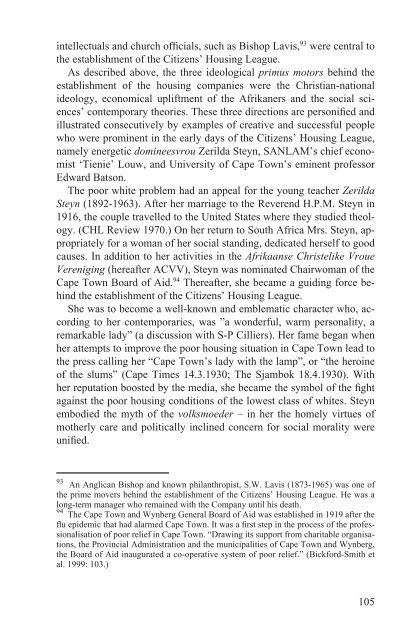The Making of a Good White - E-thesis - Helsinki.fi
The Making of a Good White - E-thesis - Helsinki.fi
The Making of a Good White - E-thesis - Helsinki.fi
You also want an ePaper? Increase the reach of your titles
YUMPU automatically turns print PDFs into web optimized ePapers that Google loves.
intellectuals and church <strong>of</strong><strong>fi</strong>cials, such as Bishop Lavis, 93 were central to<br />
the establishment <strong>of</strong> the Citizens’ Housing League.<br />
As described above, the three ideological primus motors behind the<br />
establishment <strong>of</strong> the housing companies were the Christian-national<br />
ideology, economical upliftment <strong>of</strong> the Afrikaners and the social sciences’<br />
contemporary theories. <strong>The</strong>se three directions are personi<strong>fi</strong>ed and<br />
illustrated consecutively by examples <strong>of</strong> creative and successful people<br />
who were prominent in the early days <strong>of</strong> the Citizens’ Housing League,<br />
namely energetic domineesvrou Zerilda Steyn, SANLAM’s chief economist<br />
‘Tienie’ Louw, and University <strong>of</strong> Cape Town’s eminent pr<strong>of</strong>essor<br />
Edward Batson.<br />
<strong>The</strong> poor white problem had an appeal for the young teacher Zerilda<br />
Steyn (1892-1963). After her marriage to the Reverend H.P.M. Steyn in<br />
1916, the couple travelled to the United States where they studied theology.<br />
(CHL Review 1970.) On her return to South Africa Mrs. Steyn, appropriately<br />
for a woman <strong>of</strong> her social standing, dedicated herself to good<br />
causes. In addition to her activities in the Afrikaanse Christelike Vroue<br />
Vereniging (hereafter ACVV), Steyn was nominated Chairwoman <strong>of</strong> the<br />
Cape Town Board <strong>of</strong> Aid. 94 <strong>The</strong>reafter, she became a guiding force behind<br />
the establishment <strong>of</strong> the Citizens’ Housing League.<br />
She was to become a well-known and emblematic character who, according<br />
to her contemporaries, was ”a wonderful, warm personality, a<br />
remarkable lady” (a discussion with S-P Cilliers). Her fame began when<br />
her attempts to improve the poor housing situation in Cape Town lead to<br />
the press calling her “Cape Town’s lady with the lamp”, or “the heroine<br />
<strong>of</strong> the slums” (Cape Times 14.3.1930; <strong>The</strong> Sjambok 18.4.1930). With<br />
her reputation boosted by the media, she became the symbol <strong>of</strong> the <strong>fi</strong>ght<br />
against the poor housing conditions <strong>of</strong> the lowest class <strong>of</strong> whites. Steyn<br />
embodied the myth <strong>of</strong> the volksmoeder – in her the homely virtues <strong>of</strong><br />
motherly care and politically inclined concern for social morality were<br />
uni<strong>fi</strong>ed.<br />
93 An Anglican Bishop and known philanthropist, S.W. Lavis (1873-1965) was one <strong>of</strong><br />
the prime movers behind the establishment <strong>of</strong> the Citizens’ Housing League. He was a<br />
long-term manager who remained with the Company until his death.<br />
94 <strong>The</strong> Cape Town and Wynberg General Board <strong>of</strong> Aid was established in 1919 after the<br />
flu epidemic that had alarmed Cape Town. It was a <strong>fi</strong>rst step in the process <strong>of</strong> the pr<strong>of</strong>essionalisation<br />
<strong>of</strong> poor relief in Cape Town. “Drawing its support from charitable organisations,<br />
the Provincial Administration and the municipalities <strong>of</strong> Cape Town and Wynberg,<br />
the Board <strong>of</strong> Aid inaugurated a co-operative system <strong>of</strong> poor relief.” (Bickford-Smith et<br />
al. 1999: 103.)<br />
105
















